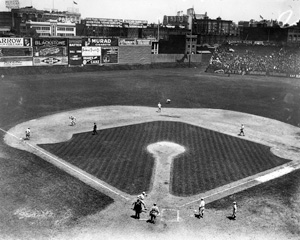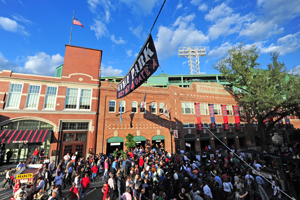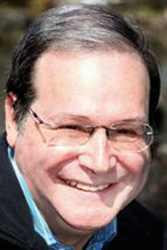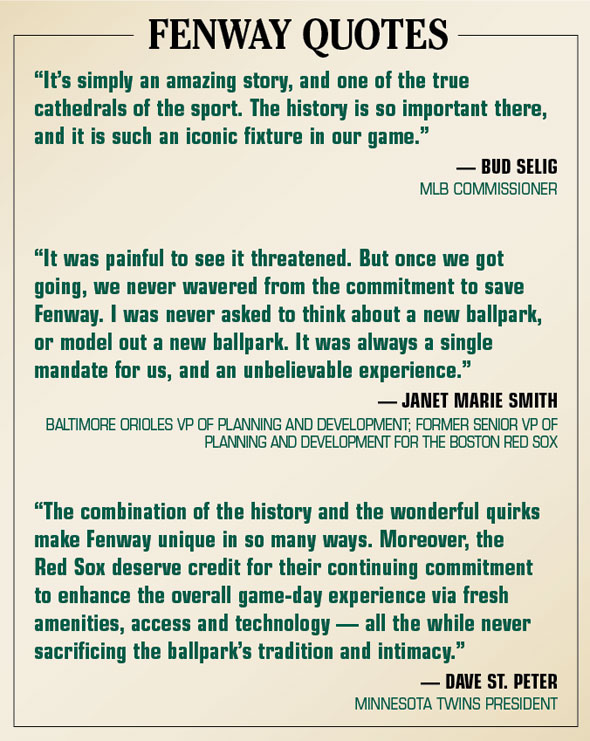Baseball’s distinguishing element, the argument goes, is its deep, continuous connection to history. It’s why the sport’s records matter more than those in other sports. It’s why the steroids issue loomed larger in baseball than any other sport. It’s why debates over the Baseball Hall of Fame spark more passion than arguments over other halls.
So the 100th anniversary of Fenway Park in Boston, set for Friday with a game for the hometown Red Sox against the archrival New York Yankees to be played in throwback uniforms, is perhaps the ultimate celebration of what makes the sport what it is.
The oldest facility in any of the major U.S. sports leagues still in active and continuous use, Fenway Park also remains the quirkiest, most unusual ballpark in MLB, most identified by the 37-foot-by-240-foot wall in left field dubbed “The Green Monster.”
“The Fenway Experience” has been an inspiration for dozens of other newer facilities, and has sparked its own literary subgenre with writers such as John Updike famously dubbing Fenway “a lyric little bandbox of a ballpark.”
 |
Billboards dotted the outfield wall as the Red Sox played this game at Fenway Park in 1917.
Photo by: Boston Red Sox |
Fenway Park reaching the century mark also contains an unlikely comeback story that on paper would probably be too unrealistic for Hollywood scriptwriters. Born misshapen into an asymmetrical Boston city block, Fenway Park saw plenty of early Red Sox success with four World Series titles between 1912-18. The ballpark was then expanded in 1933, leveled by fire the following year, quickly rebuilt, saw decades of on-field heartbreak and fan malaise, ultimately fell into shabby disrepair in the 1990s, surprisingly dodged a wrecking ball, and then was famously restored and expanded over the past decade amid a staged, $285 million renovation effort.
Now entering its second century, Fenway Park is still the fourth-smallest ballpark in MLB, holding larger seating capacities than only Miami’s new Marlins Park, the O.Co Coliseum in Oakland and Tropicana Field in St. Petersburg, Fla., the latter two of which have tarped-over seating sections. But Fenway now has a stronger infrastructure and generates more revenue than many competing facilities less than half its age.
“It’s played a role in the unfolding story of America,” said Red Sox President and Chief Executive Larry Lucchino, referring in part to Fenway Park’s recent placement on the National Register of Historic Places, a move that helps solidify its future as a protected landmark. “It has that special allure and charm that by design and by definition is not easily replicated.”
Friday’s game will be the focal point of an ongoing anniversary celebration taking place over the spring and early summer. And while there already has been plenty of commemorative product released, including a coffee-table book from the Red Sox and MLB and a documentary produced by National Geographic, the milestone for the Red Sox is more about creating a dialogue among the fan base.
“It’s really less about message, and more about the environment we’re trying to create about the personal connection people feel to this ballpark,” said Charles Steinberg, Red Sox senior adviser. Steinberg, a long ally to Lucchino, recently returned to the Red Sox after a stint working for MLB Commissioner Bud Selig. “We’re more trying to serve as a catalyst for fans to express themselves about Fenway.”
‘Roman’ renovation
Much of Fenway Park’s century of history can be distilled into the recent decade-long run of renovation work by the current John Henry-led ownership group. The $285 million effort, conducted in piecemeal during the baseball offseasons and amid often inhospitable Boston winters, was unusual in many ways.
Not only was the work not done in one big sprint, it was privately financed and involved no major rancor from public-
 |
| Photo by: National Baseball Hall of Fame Library |
 |
The ballpark’s entrance is shown in the top in Fenway’s inaugural season. The area has since evolved into the modern day Yawkey Way, which becomes a vibrant gathering place for Boston Red Sox fans and food vendors on game days.
Photo by: Boston Red Sox |
sector officials regarding approvals as Boston Mayor Thomas Menino remains one of the club’s most vocal advocates. The work notably carried Roman numeral designations each year, similar to how the Super Bowl is denoted.
Instead of focusing on the word “renovation,” the Red Sox instead chose to use the word “improvement.” “Year I Improvements” were followed by “Year II Improvements,” and so on.
“That was not by accident. We always felt this work was worthy of this kind of treatment,” Lucchino said. “We always felt we were saving one of the great venues of our time.”
The year-by-year work, however, also carried a great deal of historical forensics to learn how Fenway operated during its earlier days so as to carry out the new work in a representational fashion, and often, to spotlight how the past was influencing the present and future. The guiding principle, often repeated by Lucchino, was a borrowing of the Hippocratic Oath for doctors to “do no harm.”
That link between yesterday and today shows up even in small details, such as the font for lettering on the electronic sideboard that matches up with that on the hand-operated scoreboard at the base of the Green Monster.
Still, the Red Sox for years have conducted regular focus groups, particularly among season-ticket holders, to gauge their receptiveness to additional facility changes.
“We have repeatedly come out to them and said, ‘Are you OK with this?’ before we did anything,” said Sam Kennedy, Red Sox chief operating officer. “And admittedly, people were nervous, particularly early on.”
| FENWAY MEMORIES |
| Billy and Reggie go toe-to-toe |
 "The visiting clubhouse was hardly much better than a high school locker room, it was so cramped. It encouraged players to get out quickly. Whenever I see the visiting dugout today, I still think of Billy [Martin] and Reggie [Jackson] going at it on national TV, and how Billy used the posts supporting the roof to duck behind before sprinting around them to go after No. 44. And at one point he seems to be telling his coaches, 'OK, it's done, let it be,' and then as they back off, he bolts after Reggie again. Amazing moment. And in '75 when the league asked PR directors from non-competing teams to help out in the postseason, I was in the auxiliary press box, which was, of course, planks of wood spread across rows of upper-deck seats between first and third. I wound up sitting next to [former Red Sox star] Tony Conigliaro, who was doing TV for a local station, and that was where his seat was, after he had tried to make a comeback that year." "The visiting clubhouse was hardly much better than a high school locker room, it was so cramped. It encouraged players to get out quickly. Whenever I see the visiting dugout today, I still think of Billy [Martin] and Reggie [Jackson] going at it on national TV, and how Billy used the posts supporting the roof to duck behind before sprinting around them to go after No. 44. And at one point he seems to be telling his coaches, 'OK, it's done, let it be,' and then as they back off, he bolts after Reggie again. Amazing moment. And in '75 when the league asked PR directors from non-competing teams to help out in the postseason, I was in the auxiliary press box, which was, of course, planks of wood spread across rows of upper-deck seats between first and third. I wound up sitting next to [former Red Sox star] Tony Conigliaro, who was doing TV for a local station, and that was where his seat was, after he had tried to make a comeback that year."
-- Marty Appel
Public relations director for the New York Yankees, 1968-1977
|
The club’s current ownership, however, earned a great deal of trust with the local fan base in 2004 by breaking an 86-year-old “curse” and winning the World Series, just one year after an epic playoff loss to the hated Yankees that had even some front office executives believing the club was truly cursed.
Fans seeing how the additional revenue created was not only going into increased player payroll but also generating real on-field results created far greater public receptiveness for further changes around Fenway.
Also helping significantly was the 2003 installation of the Green Monster seats above the famous left-field wall. Providing a one-of-a-kind view into a baseball game, the seats immediately became — and nine years later remain — among the most coveted seats anywhere in baseball.
And piece by piece and year by year, as more new seating areas were installed, concourses were widened and seats were replaced, Fenway steadily became transformed, and the Red Sox, too, were transformed as a business entity. The long-cursed Red Sox, for years deemed at best a “midmarket” team, are now seen as one of two economic superpowers of the game along with the Yankees, even in the current MLB climate of on- and off-field competitive balance.
“We didn’t ever hide behind the fact that we were going to market aggressively and sell aggressively, but also use that money to help fund payroll,” Kennedy said. “That level of candor with the fans, I think, has helped a lot.”
Baltimore ties
Fenway Park is quintessentially Boston, like all good ballparks directly reflecting the spirit and character of its home city, with its traditional feel and unique, individualistic style. But the facility in many ways is intrinsically linked with Baltimore, its rival 400 miles down Interstate 95.
Babe Ruth, one of Baltimore’s most famous sons, played for six seasons at Fenway before his famous transfer to the Yankees and was a key cog in three of the four early World Series titles for the Red Sox. Another hall of famer who pounded the early Green Monster, Jimmie Foxx, also hails from Sudlersville, Md., directly across the Chesapeake Bay from Baltimore.
Much more recently, Fenway Park was a key model for the design and construction of Oriole Park at Camden Yards near Baltimore’s Inner Harbor. The idea championed in the late 1980s by Lucchino, then an Orioles executive, was to bring the old-style, baseball-centric charm of places like Fenway to Baltimore, but with modern amenities. The idea worked to spectacular success, setting off a historic two-decade development sprint of retro-themed ballparks that only now has veered in a different direction with this month’s opening of the futuristic Marlins Park.
| FENWAY MEMORIES |
| A very frigid broadcasting debut |
 "In the hotel room the morning of the game, I thought, 'You know, I'm gonna be working for the network, I'll be in a really nice glass-enclosed booth, so why do I need a topcoat and hat and gloves? They'd only get in the way.' So I left everything in the hotel room. So when I got to Fenway Park, and it's been rearranged since, there was a press box. And a roof. And I'm looking for the 'radio booth' and the writers point to the roof. And there's an engineer at a card table with a little console and a microphone and 50 yards of cable. And that was going to be my work area. So the 50 yards of cable helped, because at least I was on the roof at midfield, so if anybody moved down the line or up the line, I could walk along the roof with my microphone. Terrifying. Well, of course, it got colder and colder and colder, the wind was blowing off the river and it got dark and they had to turn the lights on. And I'm on the roof at Fenway Park in November wearing just a suit jacket. I went home afterward and I was heartsick. I could barely move my jaw, I was so cold. And I felt like, 'Here was my great chance, and I muffed it.'" "In the hotel room the morning of the game, I thought, 'You know, I'm gonna be working for the network, I'll be in a really nice glass-enclosed booth, so why do I need a topcoat and hat and gloves? They'd only get in the way.' So I left everything in the hotel room. So when I got to Fenway Park, and it's been rearranged since, there was a press box. And a roof. And I'm looking for the 'radio booth' and the writers point to the roof. And there's an engineer at a card table with a little console and a microphone and 50 yards of cable. And that was going to be my work area. So the 50 yards of cable helped, because at least I was on the roof at midfield, so if anybody moved down the line or up the line, I could walk along the roof with my microphone. Terrifying. Well, of course, it got colder and colder and colder, the wind was blowing off the river and it got dark and they had to turn the lights on. And I'm on the roof at Fenway Park in November wearing just a suit jacket. I went home afterward and I was heartsick. I could barely move my jaw, I was so cold. And I felt like, 'Here was my great chance, and I muffed it.'"
-- Vin Scully, who began his broadcasting career Nov. 12, 1949, providing the play-by-play for CBS Radio for a Boston University-Maryland football game at Fenway Park
-- As told to David Broughton
|
When Lucchino and partners Tom Werner and John Henry acquired the Red Sox in early 2002, they leaned heavily on Lucchino’s experience in Baltimore to infuse a steady series of improvements and modernizations to Fenway.
“There’s a real interesting and poignant irony that Camden Yards is now influencing the modernization of Fenway given how much Fenway influenced the creation of Camden Yards,” Lucchino said.
That symbiosis between the two facilities is in fact now cycling around a third time. Janet Marie Smith, a longtime Lucchino aide now working for the Orioles after playing an instrumental role in the Fenway renovations, is using the massive success of the Red Sox creating additional party and group seating areas to locate and develop similar opportunities in Baltimore.
“We’re now trying to find more social areas around the ballpark at Camden Yards,” Smith said, referring in part to the Orioles’ new roof deck above the center-field batter’s eye, and modifications to the ballpark’s right-field flag court. “We learned in places like Boston what big hits those areas now are.”
Industry envy
Though baseball’s run of new ballpark development of the last two decades is now nearing an end, the staged rehabilitation of Fenway has created a working model for virtually every other MLB market in addition to Baltimore.
It’s now hard not to see a ballpark, even ones that are still in the infancy of their life spans, not pushing each offseason to have some type of significant new amenity or feature for the following spring.
“In my view, Fenway Park is perhaps the most magical venue in American sport,” said Minnesota Twins President Dave St. Peter. “That Fenway Park experience — from Yawkey Way to the Green Monster seats — were significant inspirations inside the design of Target Field.”
Wrigley Field is perhaps at the very top of the list of MLB venues influenced directly by Fenway, as the 98-year-old Chicago venue carrying its own slate of physical challenges is now aggressively pursuing its own dramatic renovation to enable a second century of use.
Because of all this, Lucchino and other Red Sox executives have routinely been asked to make themselves available to other teams for advice and counsel.
“What we’ve learned here is that Fenway is its own living, breathing thing,” Lucchino said.






 "The visiting clubhouse was hardly much better than a high school locker room, it was so cramped. It encouraged players to get out quickly. Whenever I see the visiting dugout today, I still think of Billy [Martin] and Reggie [Jackson] going at it on national TV, and how Billy used the posts supporting the roof to duck behind before sprinting around them to go after No. 44. And at one point he seems to be telling his coaches, 'OK, it's done, let it be,' and then as they back off, he bolts after Reggie again. Amazing moment. And in '75 when the league asked PR directors from non-competing teams to help out in the postseason, I was in the auxiliary press box, which was, of course, planks of wood spread across rows of upper-deck seats between first and third. I wound up sitting next to [former Red Sox star] Tony Conigliaro, who was doing TV for a local station, and that was where his seat was, after he had tried to make a comeback that year."
"The visiting clubhouse was hardly much better than a high school locker room, it was so cramped. It encouraged players to get out quickly. Whenever I see the visiting dugout today, I still think of Billy [Martin] and Reggie [Jackson] going at it on national TV, and how Billy used the posts supporting the roof to duck behind before sprinting around them to go after No. 44. And at one point he seems to be telling his coaches, 'OK, it's done, let it be,' and then as they back off, he bolts after Reggie again. Amazing moment. And in '75 when the league asked PR directors from non-competing teams to help out in the postseason, I was in the auxiliary press box, which was, of course, planks of wood spread across rows of upper-deck seats between first and third. I wound up sitting next to [former Red Sox star] Tony Conigliaro, who was doing TV for a local station, and that was where his seat was, after he had tried to make a comeback that year."
 "In the hotel room the morning of the game, I thought, 'You know, I'm gonna be working for the network, I'll be in a really nice glass-enclosed booth, so why do I need a topcoat and hat and gloves? They'd only get in the way.' So I left everything in the hotel room. So when I got to Fenway Park, and it's been rearranged since, there was a press box. And a roof. And I'm looking for the 'radio booth' and the writers point to the roof. And there's an engineer at a card table with a little console and a microphone and 50 yards of cable. And that was going to be my work area. So the 50 yards of cable helped, because at least I was on the roof at midfield, so if anybody moved down the line or up the line, I could walk along the roof with my microphone. Terrifying. Well, of course, it got colder and colder and colder, the wind was blowing off the river and it got dark and they had to turn the lights on. And I'm on the roof at Fenway Park in November wearing just a suit jacket. I went home afterward and I was heartsick. I could barely move my jaw, I was so cold. And I felt like, 'Here was my great chance, and I muffed it.'"
"In the hotel room the morning of the game, I thought, 'You know, I'm gonna be working for the network, I'll be in a really nice glass-enclosed booth, so why do I need a topcoat and hat and gloves? They'd only get in the way.' So I left everything in the hotel room. So when I got to Fenway Park, and it's been rearranged since, there was a press box. And a roof. And I'm looking for the 'radio booth' and the writers point to the roof. And there's an engineer at a card table with a little console and a microphone and 50 yards of cable. And that was going to be my work area. So the 50 yards of cable helped, because at least I was on the roof at midfield, so if anybody moved down the line or up the line, I could walk along the roof with my microphone. Terrifying. Well, of course, it got colder and colder and colder, the wind was blowing off the river and it got dark and they had to turn the lights on. And I'm on the roof at Fenway Park in November wearing just a suit jacket. I went home afterward and I was heartsick. I could barely move my jaw, I was so cold. And I felt like, 'Here was my great chance, and I muffed it.'"


